Snakebite is undoubtedly one of the most frightening things that can happen to your dog during an otherwise-routine outing. The combination of your fear and your dog’s discomfort will cause even the coolest customers to melt.
But while snakebite can be a serious medical issue, dogs often have a good chance of surviving the incident and recovering completely, if provided with prompt veterinary care.
We’ll explain some of the important things dog owners need to know about snakebite below, including the venomous species of the US, the symptoms of different types of snake bite and some of the treatments for it. But we’ll begin by explaining exactly what you need to do if your dog is bitten by a snake.
Help – My Dog Was Just Bitten; I Need to Know What to Do
The two most important things you must do following a snake bite include:
- Move away from the danger. You don’t make things worse by suffering a bite yourself or allowing your dog to be bitten multiple times.
- Try to identify the snake from a safe distance. Don’t spend an hour poking through the bushes to try to find the offending serpent, but a positive ID will help immensely during the treatment phase. If possible, take a photo of the snake with your phone.
From there, you’ll want to alter your approach depending on the circumstances outlined below.
| If your dog was: | Then you should: |
| Bitten by a non-venomous snake | Wash the wound, follow up with your vet if you see any redness, swelling, discharge or lingering effects. |
| Bitten by a venomous snake | Contact your vet immediately and take your dog in for an evaluation. |
| Bitten by an unidentified snake | Contact your vet and follow the recommended course of action. |
Arm Yourself with Knowledge: Venomous Snakes in the USA
There are a couple of dozen venomous snake species in the United States (it varies because herpetologists disagree about the exact classification of some species), but most fall into one of four basic categories detailed below.
Copperheads
Copperhead photo from Wikipedia.
Copperheads are small venomous snakes that are common throughout the eastern and southern portions of the country. They can be found in upland areas as well as damp, low lying areas, where they feed on everything from large insects to frogs to rodents.
Unfortunately, copperheads often live in close proximity to suburban areas and cities, which brings them into frequent contact with people and their dogs. But fortunately, copperheads have relatively mild venom and they are generally rather shy and retiring.
You can usually identify copperheads by noting the “hourglass” pattern on their back. Young individuals have bright yellow tail tips, and copperheads of all sizes may vibrate their tails when frightened.
Cottonmouths (aka Water Moccasins)
Cottonmouth photo from Wikipedia.
Cottonmouths are closely related to copperheads, but they are a bit more dangerous than their terrestrial cousins. Cottonmouth venom is more potent than copperhead venom is, and cottonmouths frequently reach larger sizes than copperheads do.
Cottonmouths can be extremely challenging for laypersons to identify, and they are frequently confused with harmless water snakes, so it is best to simply give any snake near the water a wide berth – they won’t bother you or your pooch, if you don’t bother them.
When frightened, cottonmouths often gape their mouths, exposing the pale interior (hence their common name). Unlike non-venomous water snakes, who usually flee at the first sign of trouble, cottonmouths are typically a little bolder and more likely to stand their ground. Like copperheads, cottonmouths have bright yellow tail tips when young, and they may vibrate their tail tips when frightened.
Rattlesnakes
Rattlesnake photo (this one is a sidewinder) from Wikipedia.
Perhaps the most iconic snakes in the world, rattlesnakes are only found in North, Central and South America. Rattlesnakes range across most of the US, save for some of the northernmost regions. They are especially numerous throughout the south (Arizona holds the distinction of having more native rattlesnake species than any other state).
Rattlesnakes are relatively easy to identify in most cases: Just look for the namesake rattle at the end of their tail. However, young rattlesnakes do not have a rattle at birth (instead, they have a single segment, called a button), and adults occasionally suffer from broken rattles. This provides yet another example of the value provided by a photograph: While you may struggle to identify a rattle-less rattlesnake, experts will have no difficulty doing so.
Despite what you see in the movies, rattlesnakes are not vicious killers who lay around all day waiting for something to bite. They want to be left alone just like all other snakes, and won’t harm you unless you harm or threaten them. Nevertheless, they do require serious respect, as many rattlesnakes have very potent venom.
Coral Snakes
Coral snake photo from Wikipedia.
There are three different species of coral snake in the US, but they all look and act in pretty similar ways – at least as far as the average dog owner is concerned. Coral snakes are clad in alternating bands of red, yellow and black. These colors probably serve as camouflage against color-blind predators, but they instead serve as a warning to birds and humans.
Unlike many of the other venomous snakes in the US, coral snakes primarily feed upon other snakes. This, combined with their evolutionary history, has left them with a venom that differs significantly from that of pit vipers, like rattlesnakes, copperheads and cottonmouths. Rather than causing lots of tissue destruction, coral snake venom typically shuts down a victim’s respiratory system, leading to asphyxiation.
However, while coral snake venom is certainly dangerous, coral snakes lack the lengthy fangs that most pit vipers possess. This means that it is harder for them to inject venom, and they must typically bite a small portion of the body to effectively envenomate an animal.
Coral snakes are quite reclusive, and they aren’t seen often. They typically sleep through the day and become active at dawn and dusk.
Honorable Mention
Hognose snake photo from Wikipedia.
For the most part, the four basic groups above represent all of the dangerously venomous snakes in the United States. However, there are a few other species that scientists classify as mildly venomous. These include hognose snakes and night snakes, among others.
But while you certainly don’t want your dog to be bitten by any of these species, the chances of them becoming seriously ill from such a bite are quite low. Most of these snakes have relatively mild venom, which doesn’t cause serious problems for large mammals, and because they have fangs located at the rear of their mouth, they have a bit of trouble envenomating large animals.
Symptoms of Snakebite
The symptoms of snakebite vary based on an incredible array of variables. However, the lists below explain some of the most common things you’ll likely to see in the following circumstances:
Snakes Bitten by Non-Venomous or Mildly Venomous Snakes
Non-venomous and mildly snakes typically don’t cause many problems for dogs. Typically, the symptoms associated with a non-venomous snakebite include:
- Very minor swelling
- Minor bleeding
- Licking of the afflicted area
Snakes Bitten by “Pit Vipers” (Rattlesnakes, Copperheads or Cottonmouths)
Because most pit vipers have venom that is predominantly hemotoxic (destructive to tissues), the symptoms associated with their bites are quite obvious. Some of the most common include:
- Swelling
- Redness
- Discharge from the fang marks
- Discoloration
- Significant pain
- Licking of the afflicted area
Snakes Bitten by Coral Snakes
Unlike most other North American snakes, coral snakes have a venom that is primarily neurotoxic, meaning that it is harmful to a dog’s nervous system. Neurotoxic venoms usually don’t cause as many obvious symptoms like swelling or discoloration at the wound site; instead, they produce neurological symptoms, including:
- Lack of coordination
- Drooping eyelids
- Drooling
- Stumbling
- Lethargy
- Labored breathing
- Licking of the afflicted area
It is important to note that the symptoms of snake bite can vary quite significantly based on a variety of factors. For example, large dogs often suffer milder symptoms than smaller dogs do following a bite, as they have more body mass and blood volume. However, individual dogs exhibit varying sensitivities to different snake venoms, so even two identically sized dogs may react quite differently to similar bites.
Snakes also deliver different amounts of venom during bites. Small snakes, for example, can only inject a fraction of the venom that large snakes can, because they have smaller venom glands (and their fangs are less likely to penetrate deeply). Snakes can also meter the amount of venom they inject, and many bites are of the “dry” variety, meaning that no venom is injected at all.
What to Expect at the Vet
Your vet will likely check your pet’s vitals and inspect the bite wound. He or she may also ask you about the snake and your dog’s symptoms. From there, the vet will recommend a suitable treatment plan for your pooch, largely designed to treat the symptoms present.
For example, dogs that do not present many symptoms may require nothing more than a bit of pain medication and a few hours of observation to ensure they recover completely. On the other hand, dogs who suffer from very serious bites may require life support, surgery and/or special medication called antivenom.
Antivenom is a drug designed to counteract the effects of snake venom. It is made injecting a minute quantity of snake venom into the blood stream of a big animal, such as a horse or sheep. The larger animal’s immune system quickly goes to work and produces antibodies, which neutralize the venom. These antibodies can be removed from the animal’s blood, and then processed into an injectable drug.
Antivenom is often very effective for treating snakebite. In many cases, bite victims (both human and canine) would certainly die without it. But there is a pretty big drawback to it: Antivenom is crazy expensive. Some types cost several thousand dollars per vial, and several vials may be necessary for treatment.
Snake Vaccines
If you live in an area with a high number of venomous snakes, you may want to consider having your vet administer a snake-bite vaccine to your pup. Theoretically, such medications help prepare your dogs’ immune system for a bite, which will give him a much better chance of surviving the venom.
However, snake venom vaccinations are still relatively new, and their efficacy has not yet been firmly established. Some dogs may still fall ill after a bite, even if they’ve been given the vaccine. Some dogs may also suffer from side effects after receiving the vaccination.
Accordingly, you’ll want to discuss the possibility with your vet before making a decision. Some of the things you’ll both want to consider include:
Your Geographic Location
If you live in Maine or Montana, the chances of snake bite are very low, so your vet may recommend foregoing a snake vaccine. On the other hand, dogs living in the southern portion of the US are more likely to encounter venomous snakes, thereby changing the risk-reward algebra.
Your Dog’s Stomping Grounds
If your dog’s walks are limited to city parks and streets, he probably won’t encounter many snakes, so it probably won’t make sense to vaccinate him against venom. But if your dog romps around in forests, fields and ponds in suburban or rural areas, it may be a good idea to have him vaccinated.
Your Dog’s Age, Size and Health
Healthy adult dogs are better able to withstand snake bites than young, old or sick dogs are, and this should be considered along with the other factors explained above. It is also important to consider your dog’s size: A rattlesnake bite is bad news for a Newfoundland, but it is likely to be even worse for a Chihuahua.
Your Proximity to Veterinary Help
If you live in a sparsely populated area, far from veterinary help, you may be more inclined to have your pup vaccinated. You’ll still want to head to the vet following a bite, but because your dog will have received some protection from the vaccine, you’ll likely have more time to get him to the vet for treatment (if needed – hopefully, his vaccinated body will handle the venom for you).
Home Treatment for Non-Venomous Bites
In most cases, you can take care of a non-venomous snake bite at home yourself – just be 100% certain the snake in question wasn’t venomous before doing so. Snake bites are like any other type of puncture wound, so they require broadly similar treatment.
Wash the bite wound with a little soap and warm water. Dry it off gently by patting it with a towel.
Gently run your finger across the bitten area to feel for any teeth that were left in the wound (snake teeth frequently break off when they bite a large animal). You can try to pull or scrape out any lodged teeth yourself, but be sure to visit the vet if you find any embedded beneath your dog’s skin.
Keep the area clean and dry. Monitor it for the next few days to ensure it is healing properly – if you notice significant swelling, redness or discharge contact your vet for further treatment.
In general, the teeth of non-venomous snakes in the United States are much smaller than people assume, so the wounds caused by them are minor and rarely cause problems. However, as snakes spend their lives eating filthy animals, drinking from dirty mud puddles and only rarely brushing their teeth, their mouths are full of bacteria. This means that infection is always one of the biggest threats posed by such bites.
Preventing Snake Bites
Of course, the best way to deal with a snake bite is to prevent them in the first place. While it is difficult to completely eliminate the possibility that your pooch will be bit, you can reduce the chances of this happening by following the strategies explained below.
- Keep your dog leashed and under your supervision whenever you are traveling through areas that may harbor snakes. While some dogs appear frightened of snakes, most investigate snakes upon discovery, and some (especially pest-killing breeds, such as terriers) treat snakes like chew toys. You must be there to check potentially dangerous impulses.
- Don’t allow your dog to walk in high grass or dense vegetation. Snakes are hunted by just about every medium-sized predator imaginable, so they hide amid vegetation (and other types of cover) for most of their lives. Just keep your dog out of these areas and you’ll drastically reduce the odds of a bite.
- Teach your dog a “leave it!” command. Anytime your dog approaches a snake (or anything else that may be dangerous), tell him to leave it, and then have him come sit by your side.
- Use care when walking in low-light conditions. Snakes are often most active in the early morning and late evening, when the light is relatively low; and some become almost entirely nocturnal during the heat of the summer. This doesn’t mean you can’t go for a nighttime stroll with Fido, just that you should bring a flashlight, watch where you are both walking and stick to the best-lit places available.
Most snakes will retreat if given the chance to do so, so the most important thing to do is simply give them space. In fact, if a snake sees, smells or feels you or your dog coming, he’ll usually sneak off before you even know he is there.
Unfortunately, there aren’t a ton of ways to let snakes know you and your canine are heading their way. They don’t see especially well, so don’t try to wave your arms while walking your dog. This will repel your friends and neighbors rather than snakes. And there’s not much you could do to help them smell you coming, either (insert flatulence joke here).
However, it’s not a bad idea to stomp your feet a little before heading through snake country. This may alert them to your presence and convince them to scoot off, while only making you look slightly goofy. Snakes can’t hear airborne sounds, but they can feel vibrations that pass through the ground.
And while we are on the subject of snake repulsion, do yourself a favor and skip the “snake repellents” sold online and in hardware stores. They don’t work, and you’ll just be wasting your money. The best way to reduce the number of snakes living on your property is to keep things tidy, and remove anything that may attract rodents, such as spilled birdseed.
Snakebite is a relatively rare phenomenon that is much less common than people suppose. Snakes generally avoid big, scary predators like you and your dog, and they are always keen to avoid a potentially deadly encounter. After all, snakes are on the menu for most predators they encounter, so the old “they’re more afraid of you than you are of them” adage holds true.
Has your dog ever been bitten by a snake? Did you determine what type of snake was involved in the encounter? Was it a venomous species? Did your dog require veterinary care?
Share your experiences in the comments below.

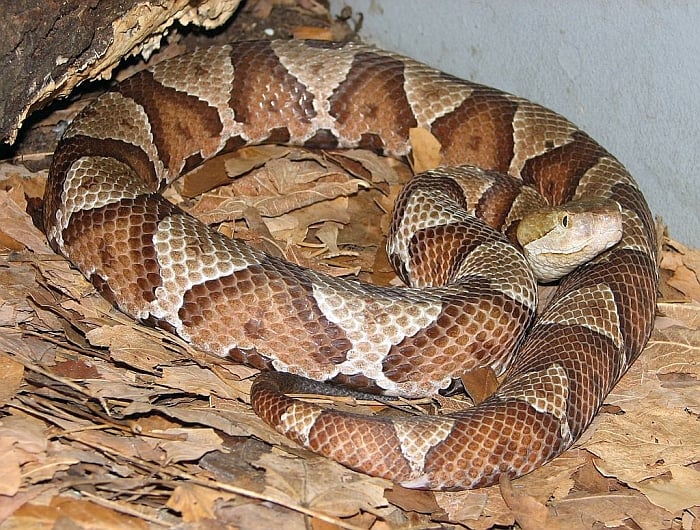
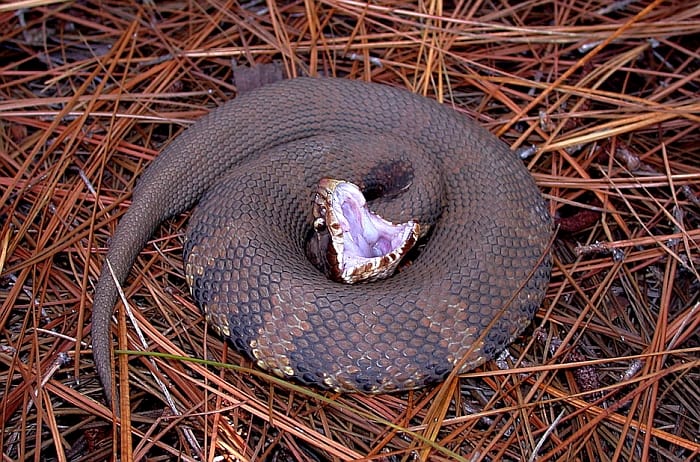
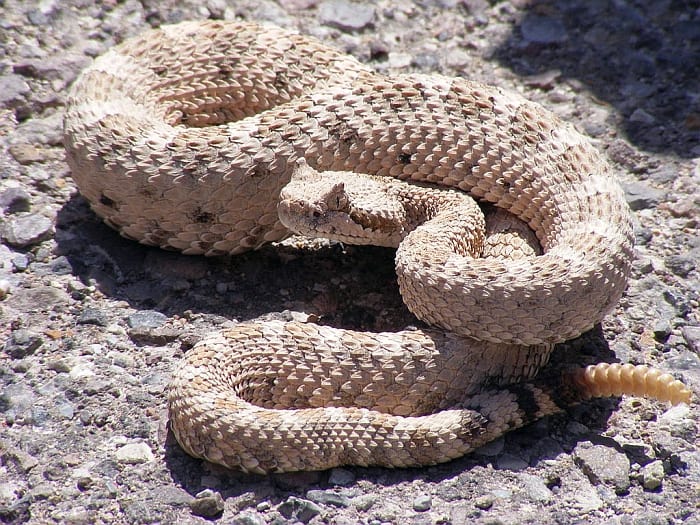
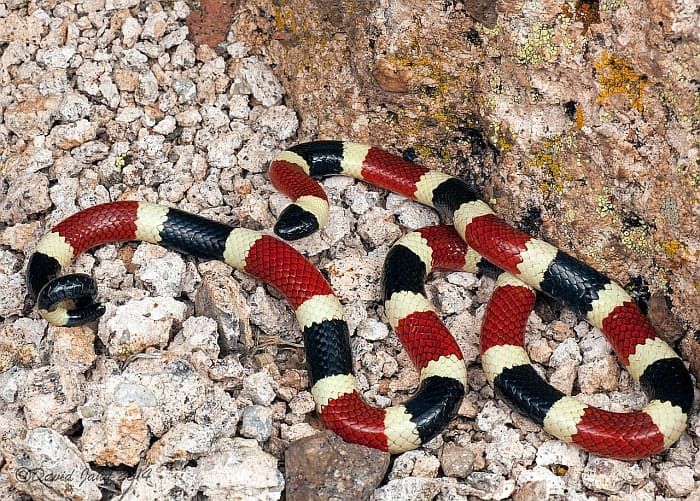
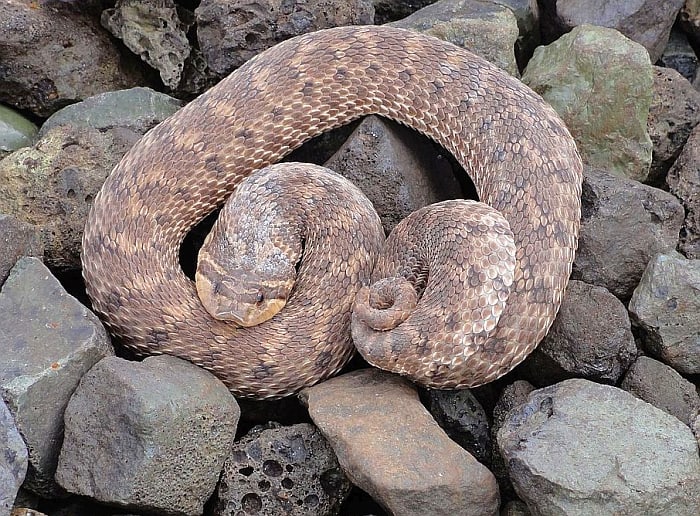

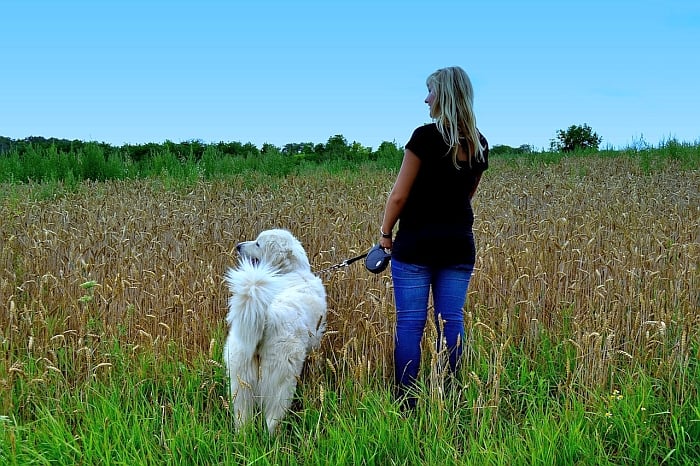
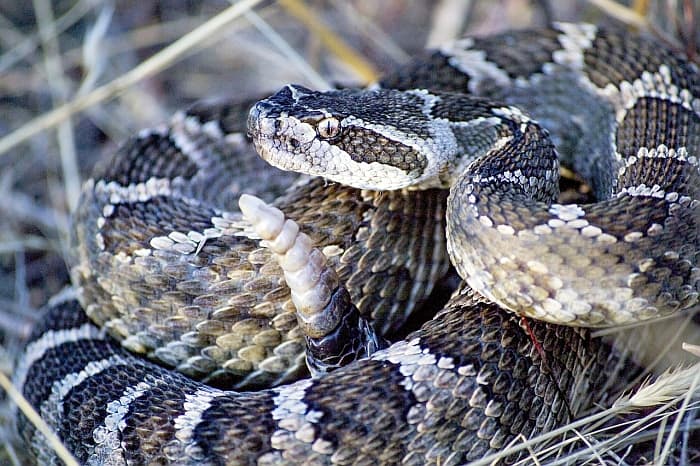



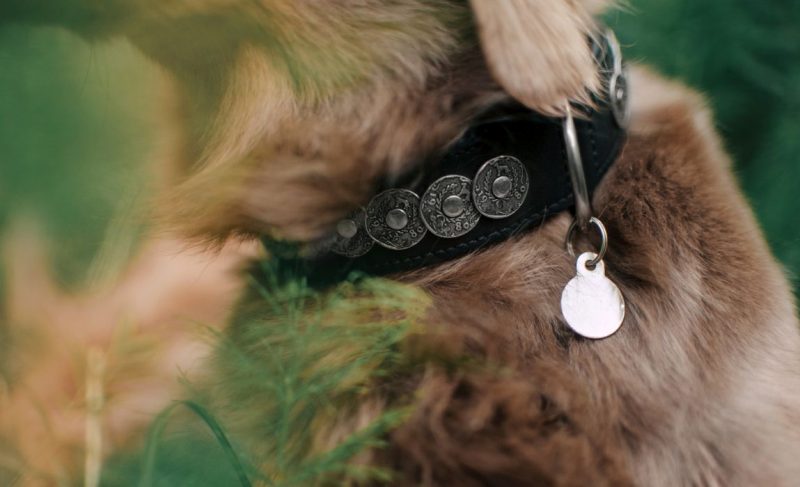



Leave a Comment